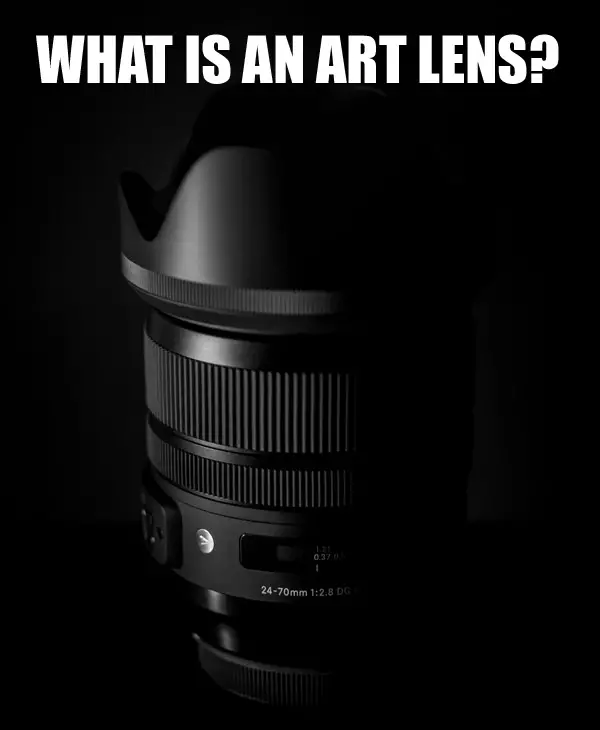What is an Art Lens
If you are looking to buy a new lens for your camera, and one of the camera manufacturer options that you’ve been looking into are Sigma lenses, then you might have bumped into Sigma’s Art line or something called Art Lenses.

This could happen if you are looking into buying lenses created with exceptional focal plane sharpness and just great optical performance that ensures stunning image quality.
In case this phrasing has confused you, and you’ve been wondering what an art lens actually is, you’ve come to the right place, as all those lenses have some things in common, and all of them will be explained down below.
Art Lens vs. Normal Lens
When you hear the wording “art lens,” that can imply quite a lot of things, mainly that these are some kind of prime lenses created to give you maximum aperture range and exceptional sharpness.
So, is this true, and are these Sigma art lenses designed specifically for that?
Some may argue that you can get sharp images even with cameras that aren’t from the Sigma art series, so what are their specific benefits?
And finally, how different truly is a Sigma art lens compared to a normal lens?
What Is An Art Lens
When referring to lenses as art lenses, people usually mean the Sigma art lenses from their Art series.
An Art lens is a special kind of lens made by Sigma that is mainly used for more artistic photographs.

Sigma actually has three different series, the Art series, Sport lenses, and a Contemporary line.
The Art series lenses are lenses with wide-aperture, high-quality optics, and construction, but they are not telephoto in particular.
The Contemporary lenses are on the lower end and they have a very broad zoom range which is great but does compromise the overall performance of the lenses.
Sport lenses are quicker telephoto lenses designed for sports photography, with a more sturdy structure and more appropriate optical performance.
Whichever you need, you will be able to use it with all different camera body options, so it doesn’t matter if you have a Sony, Canon, Nikon, Leica, Pentax, or Panasonic; the Sigma art lenses are going to be compatible (click on links for examples).
The Sigma Art line is the most professional one out of the three, and most people see it as a cheaper alternative to some more top-notch options like Canon L, Canon EF, or Sony G Master.
There are even people who will go so far as to say that the Sigma Art lenses are better and give more high-quality photos.
Overall, the photos you get with these lenses are made to look like art pieces.
When it comes to the maximum aperture range of the Sigma Art lenses, they go from f/1.4 to f/2.8, which means that the colors are very vivid and have the sharpest details.
The aperture is wide open, so that plays a big part in getting a beautiful bokeh.
Another thing that they apply when creating these lenses is the low-dispersion elements, and they also prioritize the minimization of any possible aberration.
These were all of the benefits that many Sigma Art lens users, including myself, have found to be true about them.
However, as with any other lenses, there are some downsides and drawbacks with the Sigma Art lenses, too.
The main thing that is a consistent re-occurrence with these Art lens options is the fact that the autofocus often gets missed.
But on the other hand, if you use a manual focus ring, then this won’t be an issue since focusing manually works great.
These lenses are something more professional that you can get at a lower price, so that would be their main benefit.
What Is A Normal Lens
Technically, a normal lens in photography and cinematography is one that reproduces a field of view that appears “natural” to a human spectator.
Depth compression and expansion with shorter or longer focal lengths, on the other hand, generate significantly, and sometimes unpleasant, distortion.
Just as in life, when we say something is normal, we don’t truly know with a hundred percent certainty what “normal” is; there are some problems with this definition in photography, too.
In order to test whether a lens is normal or not, you would have to find something that gets a printed photograph of a scene that’s taken at a distance of arm’s length.
If the perspective that you get on the photo is the same as how something is in real life, then a lens can be considered normal.
A lens that is considered to be a normal lens usually has an angle of view that is close to one radian (57.296 degrees), and the focal length that this type of lens works with is around 39.6mm.
However, the focal length of a normal lens can differ depending on what you use it for.
When talking about a normal lens, people usually have in mind something that has a focal length that’s between 35mm and 50mm, and that would also be called a standard lens.
That exact focal length is what gives these lenses the similarity to the human eye, as that’s very close to how we see.
Speaking of usage, normal lenses are mainly used by professionals when they want to achieve something that looks more natural and grounded, which makes sense with all the similarities with the human eye.
These lenses usually tend to be either equal to the length of the diagonal of the sensor in a digital camera, or equal to the film format, in case it’s not a digital camera.
How Is an Art Lens Different From a Normal Lens
When it comes to a Sigma Art lens, what it mainly gives you are sharp images and very sharp details.

This, of course, produces somewhat higher quality images, but besides the quality, they more have the look of artistic expression with finer details.
They do have excellent performance and compact design, and they are also more affordable than some other options.
But the main difference comes with things like architecture photography, low light photography, landscape photography, and even portrait photography, where you need to capture more details with wide-angle lenses.
Besides that, the wording Art lens doesn’t have much other meaning besides being Sigma’s line, and it’s not a general type of a lens, but rather something regarding Sigma lenses.
Other studio photography manufacturers have their own versions of this, so you can even have Nikon lenses or Canon ones with the same characteristics.
Should You Buy An Art Lens

When speaking of full-frame lenses, you have a lot to choose from, and especially if you need something on a budget, Sigma art lenses can be something to look into.
They have a versatile lenses to offer, and among all of that is their Art lens.
So, should you buy one for yourself?
If you are on a budget, but you want something that will provide you with sharpness and a lot of details, then sure, go for it!
Sigma is a good company whether it comes to fast aperture lenses or anything else, so you generally won’t be disappointed.
The image quality is great, and whenever I tried something from them, it was worth the price.
But, if these things aren’t your priority, then sticking to your normal lenses could absolutely be enough for you.
FAQ
Can you use an Art lens for video?
Sigma art lenses are mainly meant for professional artistic photography and give great image quality, but they can still be used for video.
While it wouldn’t be most people’s first choice for videos, it certainly can make some good ones if that’s what you have and need to make a video.
What does contemporary lens mean?
SIGMA describes its Contemporary lenses as compact, high-quality, and cheap, designed to fulfill the needs of a diverse range of artists who just want beautiful photographs and product quality without breaking the budget.
They are mainly made for real-world use.
I hope you found this article helpful. Click here to learn which lens to choose for your needs.




